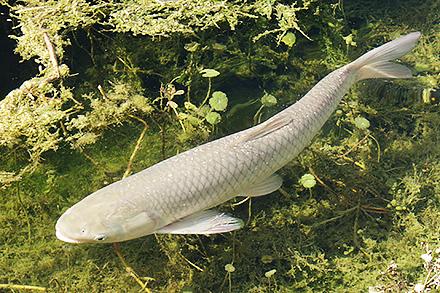Fish as Feed/Fish as Food

Grass carp are among several types of invasive Asian carp that threaten rivers and the Great Lakes. (Photo by Buck Albert, U.S. Geological Survey, D1566-1)
As many anglers know, carp are not welcome when found dangling from the hook. Classified by U.S. government as an invasive species and known colloquially as a "trash fish," carp can take over and devastate every watery environment they enter. They’re not particularly well known in this country as good eating fish, either.
Carp have been in the United States for over 100 years. In 2013, the Agricultural Research Service (ARS) joined other research partners to look for ways to mitigate the impact of these fish after the latest invaders – bighead, black, silver, and grass carp – found their way into the Mississippi and other rivers as well as the Great Lakes.
"Invasive carp outcompete native fish for food and space, starting at the base of the ecosystem," said Wendy Sealey, fish physiologist with ARS. Sealey conducts her research at the Bozeman Fish Technology Center, in Bozeman, MT.
According to Sealey, invasive carp females produce larger numbers of offspring annually than native fish and those fish – both mature and young – compete directly with native fish for food sources, primarily plankton. Plankton are the small and microscopic organisms that float in the water, including the eggs and larval stages of various water animals.
To help curb the numbers of invasive fish, researchers began testing whether carp could be used as a replacement for wild-caught marine fish meal in aquatic animal feeds. Fish meal is an important and expensive ingredient used in aquafeeds with an annual production of approximately 5 million tons.
"There is a need for additional protein sources for aquaculture feeds if aquaculture is to continue to grow," Sealey said. "And it is appealing to grow aquaculture while also trying to reduce an environmental problem, like invasive carp."
The project was a preliminary study to assess the quality of carp fishmeal, and results demonstrated that it could be used as a feed ingredient for hybrid striped bass and rainbow trout. Targeted fishing also lowered carp populations in the project areas. That’s important because there’s a new interest in the targeted fishing of carp, this time from the restaurant community.
According to published articles, restauranteurs large and small are serving up carp to their customers under the re-branded name of "copi." Even the World Wildlife Fund is promoting carp as pet food. Reportedly, copi is a flavorful fish, whose main drawback is its high number of fine bones.
"Projects like the initial ARS study are still relevant because the issue of invasive carp is ongoing and evolving," Sealey said. "The collaborative approach of the research and resource agency groups displays hope for how the complex issues [of invasive carp] extend well beyond just the science and require diverse team/approaches to have true impact." – by Scott Elliott, ARS Office of Communications

